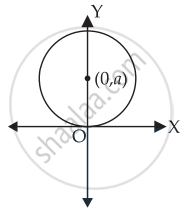Advertisements
Advertisements
प्रश्न
Form the differential equation of all circles which pass through origin and whose centres lie on y-axis.
उत्तर

Equation of circle which passes through the origin and whose centre lies on y-axis is
(x – 0)2 + (y – a)2 = a2
⇒ x2 + y2 + a2 – 2ay = a2
⇒ x2 + y2 – 2ay = 0 ......(i)
Differentiating both sides w.r.t. x we get
⇒ `2x + 2y * "dy"/"dx" - 2"a" * "dy"/"dx"` = 0
⇒ `x + y "dy"/"dx" - "a" * "dy"/"dx"` = 0
⇒ `x + (y - "a") * "dy"/"dx"` = 0
`y - "a" = x/("dy"/"dx")`
a = `y + (-x)/("dy"/"dx")`
Putting the value of a in equation (i), we get
`x^2 + y^2 - 2(y + x/("dy"/"dx"))y` = 0
⇒ `x^2 + y^2 - 2y^2 - (2xy)/("dy"/"dx")` = 0
⇒ `x^2 - y^2 = (2xy)/("dy"/"dx")`
∴ `(x^2 - y^2) "dy"/"dx" - 2xy` = 0
Hence, the required differential equation is `(x^2 - y^2) "dy"/"dx" - 2xy` = 0
APPEARS IN
संबंधित प्रश्न
Form the differential equation of the family of parabolas having vertex at origin and axis along positive y-axis.
For the curve y = 5x – 2x3, if x increases at the rate of 2 units/sec, then find the rate of change of the slope of the curve when x = 3
Form the differential equation of the family of curves represented by y2 = (x − c)3.
Form the differential equation from the following primitive where constants are arbitrary:
y = ax2 + bx + c
Form the differential equation corresponding to y2 = a (b − x2) by eliminating a and b.
Represent the following families of curves by forming the corresponding differential equations (a, b being parameters):
x2 + y2 = a2
Represent the following families of curves by forming the corresponding differential equations (a, b being parameters):
x2 − y2 = a2
Represent the following families of curves by forming the corresponding differential equations (a, b being parameters):
y2 = 4ax
Represent the following families of curves by forming the corresponding differential equations (a, b being parameters):
x2 + (y − b)2 = 1
Represent the following families of curves by forming the corresponding differential equations (a, b being parameters):
(x − a)2 − y2 = 1
Form the differential equation of the family of circles in the second quadrant and touching the coordinate axes.
Find one-parameter families of solution curves of the following differential equation:-
\[\frac{dy}{dx} - y = \cos 2x\]
Find one-parameter families of solution curves of the following differential equation:-
\[x\frac{dy}{dx} - y = \left( x + 1 \right) e^{- x}\]
Find one-parameter families of solution curves of the following differential equation:-
\[\left( x \log x \right)\frac{dy}{dx} + y = \log x\]
Find one-parameter families of solution curves of the following differential equation:-
\[e^{- y} \sec^2 y dy = dx + x dy\]
Find one-parameter families of solution curves of the following differential equation:-
\[x \log x\frac{dy}{dx} + y = 2 \log x\]
The family of curves in which the sub tangent at any point of a curve is double the abscissae, is given by
Form the differential equation of the family of ellipses having foci on y-axis and centre at the origin.
Find the equation of a curve whose tangent at any point on it, different from origin, has slope `y + y/x`.
The solution of the differential equation `2x * "dy"/"dx" y` = 3 represents a family of ______.
Find the differential equation of system of concentric circles with centre (1, 2).
The curve for which the slope of the tangent at any point is equal to the ratio of the abcissa to the ordinate of the point is ______.
The differential equation of the family of curves y2 = 4a(x + a) is ______.
Find the equation of the curve at every point of which the tangent line has a slope of 2x:
From the differential equation of the family of circles touching the y-axis at origin
Form the differential equation of the family of hyperbola having foci on x-axis and centre at origin.
